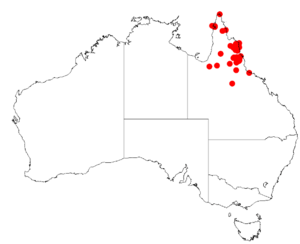Irvinebank wattle facts for kids
Quick facts for kids Irvinebank wattle |
|
|---|---|
| Scientific classification | |
| Genus: |
Acacia
|
| Species: |
leptoloba
|
 |
|
| Occurrence data from AVH | |
The Acacia leptoloba, also known as the Irvinebank wattle, is a type of shrub or small tree. It belongs to the Acacia family, which is a large group of plants. This specific wattle is found only in a certain area of northeastern Australia.
What Does It Look Like?
This shrub or small tree usually grows to be about 5 meters (16 feet) tall. It has branches that spread out. The branches are smooth and sometimes have a fine white powder on them.
Like most Acacia plants, the Irvinebank wattle has special leaf-like structures called phyllodes instead of true leaves. These phyllodes are smooth, tough, and stay green all year. They are shaped like a sickle and are about 7 to 12 centimeters (2.8 to 4.7 inches) long. They are also about 18 to 33 millimeters (0.7 to 1.3 inches) wide. Each phyllode has three main lines running along it.
The Irvinebank wattle blooms between December and April. It produces round flower-heads that are about 8 millimeters (0.3 inches) across. Each flower-head has 40 to 75 white flowers. These flower-heads grow in clusters along the branches.
How It Got Its Name
The Irvinebank wattle was first officially described by a botanist named Leslie Pedley in 1978. He wrote about it in a scientific paper.
For a short time in 1987, its name was changed to Racosperma leptolobum. However, in 2001, it was changed back to its original name, Acacia leptoloba.
Where Does It Grow?
This plant is found in different spots across the Cape York Peninsula in far north Queensland. It grows as far south as the area around Herberton.
You can often find it on hills and along creeks. It prefers to grow in sandy soils. The Irvinebank wattle is quite common around the Irvinebank area, which is how it got its common name.

